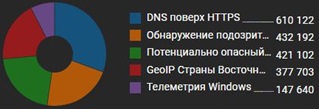
Analyzing and Predicting the Time Series of Cyberattacks on Higher Education Departmental Institution Information System: Methods Opportunities and Limitations
https://doi.org/10.31854/1813-324X-2025-11-1-99-112
EDN: OOPJJR
Abstract
The article relevance is due to the growing threats to computer security of critical information resources, including in the education system, cyberattacks types and trends diversity, requiring known analysis and forecasting methods differentiation, including those based on the use of time series theory. The article aim is to study the possibilities and limitations of using time series theory methods to analyses and predict the cyber attacks dynamics on the departmental university example that trains specialists in many security types: technosphere, fire, information and other. Hypothesis about the influence of the initial data nature on the methods for cyberattacks number time series analyzing and forecasting choice, and primacy of initial data on the solving these tasks effectiveness was stated and tested. Analyses of the corporate information system firewall monitoring logs are performed. On their basis, time series number of different types of attacks are constructed. The tasks of building mathematical models and current forecasting have been solved. An integrated approach to their solution based on preliminary processing, testing of statistical hypotheses about DS- and TS-stationarity and use of different forecasting methods was applied. The obtained results novelty is due to known methods of time series forecasting theory application to studying the dynamics of cyberattacks on the departmental university corporate information system. Theoretical significance consists in establishing the limits of their application possibility due to the studied time series variability, as well as in confirming the initial data primary quality over the existing methods and models. The practical value is determined by the time series models construction that allow solving tasks of cyberattacks number current forecasting.
Keywords
About the Authors
V. N. NaumovRussian Federation
M. V. Buinevich
Russian Federation
M. Y. Sineshchuk
Russian Federation
M. A. Tukmacheva
Russian Federation
References
1. Glazyev S.Yu. Theory of Long-Term Technical and Economic Development. Moscow: VlaDar Publ.; 1993. (in Russ.) EDN:YSXIUV
2. Nielsen E. Practical Time Series Analysis. Forecasting with Statistics and Machine Learning. St. Petersburg: Dialektika Publ.; 2021. 544 p. (in Russ.)
3. Hyndman R.J., Athanasopoulos G. Forecasting: principles and practice. OTexts; 2017. 292 p.
4. Isaev S.V., Kononov D.D. A Study of Dynamics and Classification of Attacks on Corporate Network Web Services. The Siberian Aerospace Journal. 2022;23(4):593–601. (in Russ.) DOI:10.31772/2712-8970-2022-23-4-593-601. EDN:RUSJWB
5. Zuzčák M., Bujok P. Using honeynet data and a time series to predict the number of cyber attacks. Computer Science and Information Systems. 2021;18(4):1197–1217. DOI:10.2298/CSIS200715040Z
6. Larionov K.O. Forecasting Attack Statistics on Applied Software. Problemy sovremennoi nauki i obrazovaniia. 2021;6(163):57‒63. (in Russ.) DOI:10.24411/2304-2338-2021-10606. EDN:PGVALC
7. Hobijn B., Franses P.H., Ooms M. Generalization of the KPSS-test for stationarity. Statistica Neerlandica. 2004;58(4): 482‒502. DOI:10.1111/j.1467-9574.2004.00272.x
8. Phillips P.C.B., Perron P. Testing for a Unit Root in Time Series Regression. Biometrika. 1988;75(2):335‒346. DOI:10.1093/biomet/75.2.335. EDN:ILNEET
9. Hersbach H. Decomposition of the Continuous Ranked Probability Score for Ensemble Prediction Systems. Weather and Forecast. 2000;15(5):559–570. DOI:10.1175/1520-0434(2000)015<0559:DOTCRP>2.0.CO;2
10. Dawid A.P., Sebastiani P. Coherent Dispersion Criteria for Optimal Experimental Design. Annals of Statistics. 1999; 27(1):65‒81.
11. Bickel P.J., Doksum K.A. An Analysis of Transformations. Journal of the American Statistical Association. 1981;76(374): 296‒311. DOI:10.2307/2287831
12. Hyndman R.J., Koehler A.B., Snyder R.D., Grose S. A state space framework for automatic forecasting using exponential smoothing methods. International Journal Forecasting. 2002;18(3):439–454.
13. Cleveland R.B., Cleveland W.S., McRae J.E., Terpenning I.J. STL: A Seasonal-Trend Decomposition Procedure Based on Loess. Journal of Official Statistics. 1990;6(1):3–33.
14. Scott S., Varian H.R. Predicting the Present with Bayesian Structural Time Series. SSRN Electronic Journal. 2014;5(1/2):4–23. DOI:10.1504/IJMMNO.2014.059942
15. Mastitsky S.E. Time series analysis using R. 2020. URL: https://ranalytics.github.io/tsa-with-r [Accessed 19.12.2024]
Review
For citations:
Naumov V.N., Buinevich M.V., Sineshchuk M.Y., Tukmacheva M.A. Analyzing and Predicting the Time Series of Cyberattacks on Higher Education Departmental Institution Information System: Methods Opportunities and Limitations. Proceedings of Telecommunication Universities. 2025;11(1):99-112. (In Russ.) https://doi.org/10.31854/1813-324X-2025-11-1-99-112. EDN: OOPJJR


































